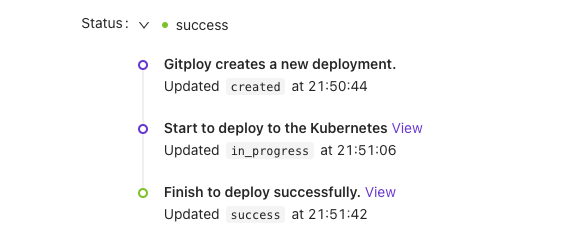How it works
Gitploy builds the system around GitHub deployment API. Deployment API is a request to deploy a specific ref (branch, SHA, tag), and GitHub dispatches an event to deployment toolings that can listen for and act on when a request is posted. It's an event-driven decoupled way to deploy your code. This article looks under the hood Gitploy interacts with deployment API.
GitHub Deployment API
The deployment API consists of these stages:
- A user selects a ref(branch, SHA, tag) to deploy.
- It verifies the ref for deployment safety.
- It requests GitHub to deploy a specific ref.
Of course, Gitploy follows these stages to deploy a ref and enhances each stage to use it easily and safely.
Select a ref(branch, SHA, tag)
A ref can be any named branch, tag, or SHA, and it is determined by how to deploy an application. If an application uses semantic versioning, the ref should be a tag(e.g., v0.5.5).
Gitploy provides an intuitive UI similar to GitHub, enabling users to select a ref easily even though a user is a newcomer to the system. And it displays the details of a commit such as SHA, message, creator, and creation time. So it enables to let users know which commits are deployed.
Verification
Before deploying a ref, it needs verification for deployment safety. The deployment API provides these verifications:
auto_merge: Ensure that the requested ref is not behind the repository's default branch.required_contexts: Ensure that commit statuses are in that success state.
Gitploy provides the file (i.e., deploy.yml) to configure the parameters for each runtime environment, respectively.
Event Dispatch
Gitploy posts a request to GitHub, and it dispatches an event to deployment toolings.
Deployment Tooling
Update status
After deployment, a deployment tooling must update the deployment status if it has succeeded or not by the deployment status API. It enables Gitploy to sync the deployment status and display the deployment status with a redirection link for the deployment details, such as logs.

Below is a simple diagram for how these interactions would work:
+---------+ +--------+ +---------+ +-------------+
| Gitploy | | GitHub | | Tooling | | Your Server |
+---------+ +--------+ +---------+ +-------------+
| | | |
| Create Deployment | | |
|--------------------->| | |
| | | |
| Deployment Created | | |
|<---------------------| | |
| | | |
| | Deployment Event | |
| |---------------------->| |
| | | SSH+Deploys |
| | |-------------------->|
| | | |
| | Deployment Status | |
| |<----------------------| |
| | | |
| | | |
| | | |
| | | Deploy Completed |
| | |<--------------------|
| | Deployment Status | |
| |<----------------------| |
| | | |
| | | |
| | | |
Keep in mind that Gitploy is never actually accessing your servers. It's up to your tools to interact with deployment events.